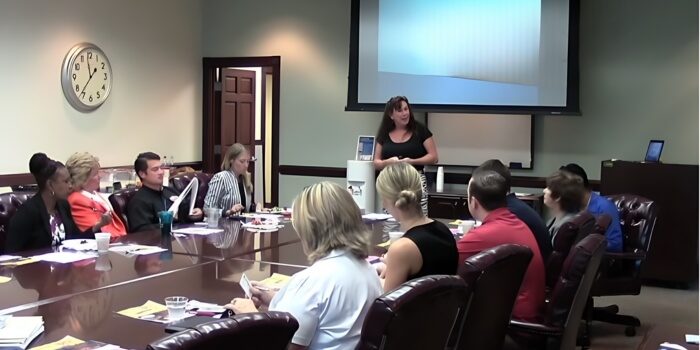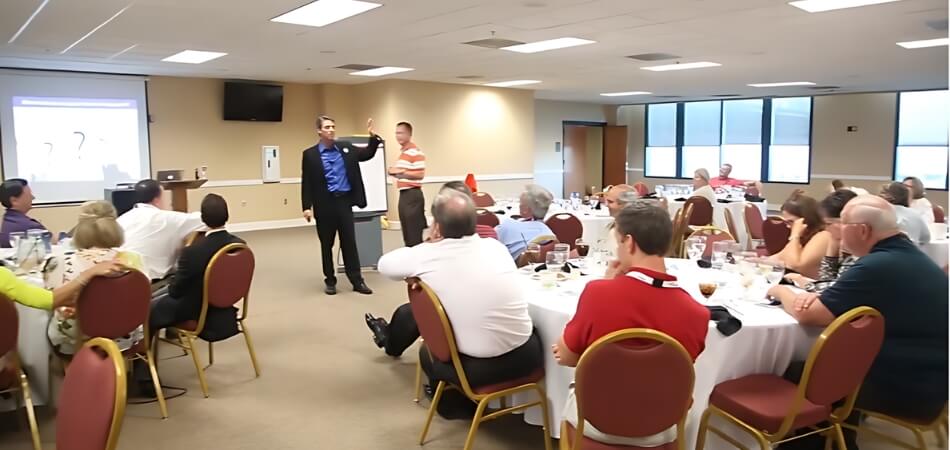It is extremely important that you prepare your team for a trade show so that you can achieve unprecedented success. Trade shows are unique platforms where businesses showcase their products and services, interact with potential clients, and network with industry peers.
To manage these opportunities effectively, your staff needs more than just a basic understanding of your offerings. They need a strategic approach, combining theoretical knowledge with practical skills. That’s where our ultimate guide to effective trade show staff training comes in.
In general, trade show staff training is designed to transform your team into a well-oiled machine, ready to make the most of every interaction. From assessing current skills to developing a tailored training plan, and finally, implementing it using various methods like workshops and role-playing.
Stay with us as we dive into the secrets of turning your staff into trade show superstars.
Why Trade Show Staff Training Really Matters?
The core essence of trade show staff training is to empower your team with the skills and knowledge they need to thrive in the dynamic environment of a trade show.

It’s about ensuring they can confidently engage with visitors, effectively communicate your brand’s message, and maximize lead generation opportunities. By undergoing comprehensive training, your staff will be able to cope with the hectic atmosphere, handle inquiries with ease, and make a lasting impression on potential clients.
This training is crucial for aligning your team with your business goals. It encourages a sense of unity and promotes a professional image that reflects the quality of your products or services. Ultimately, well-trained staff can significantly enhance your trade show presence, leading to increased brand awareness and a higher return on investment.
Why is it Needed to Train the Staff of Trade shows?
A trade show’s staff should be trained just like an arrow that is being sharpened for a big hunt. It’s not just about showing up; it’s about making an impact. Here are some reasons why it’s crucial.
Enhanced Communication Skills
Your team needs to articulate your brand’s message clearly and effectively. Training helps them develop the communication skills necessary to engage visitors and understandably convey complex information.
Professionalism and Confidence
A well-trained staff exudes professionalism and confidence. This not only leaves a positive impression on visitors but also boosts your team’s morale and self-assurance.
Improved Lead Generation
Trade shows are all about generating leads. Trained staff can identify potential clients, engage them in meaningful conversations, and gather valuable contact information.
Product Knowledge
Your staff should know your products or services inside out. Training ensures they can answer questions, demonstrate features, and address concerns with ease.
Crisis Management
Unexpected situations arise. Training your staff in crisis management helps them handle any issues calmly and efficiently, maintaining a smooth flow at your booth.
Ultimate Guide to Effective Trade Show Staff Training
You should prepare your trade show staff the same way you would prepare a team for a big game. It’s all about strategy, skills, and execution. Our ultimate guide to effective trade show staff training ensures your team hits the ground running.

From mastering product knowledge to perfecting engagement, this guide covers it all. Let’s dive into the key steps to turning your staff into trade show champions.
Step 1: Assess Staff Skills and Knowledge
Start by evaluating your team’s current abilities and understanding of your products or services. Identify any gaps in knowledge or skills that could hinder their performance at the trade show.
Step 2: Set Clear Objectives
Define what you want to achieve with your trade show presence. Whether it’s generating leads, increasing brand awareness, or launching a new product, your objectives will guide the training process.
Step 3: Develop a Training Plan
Create a comprehensive plan that covers all aspects of trade show participation. This should include product knowledge, sales techniques, customer engagement strategies, and booth etiquette.
Step 4: Product Knowledge Training
Ensure your staff knows your offerings inside out. For them to be successful, they should be able to answer questions, demonstrate features, and explain benefits with confidence.
Step 5: Communication and Engagement Training
Teach your team how to effectively communicate with booth visitors. This includes active listening, asking open-ended questions, and tailoring their approach to different types of attendees.
Step 6: Sales and Lead Generation Techniques
Equip your staff with strategies to identify potential leads and guide them through the sales funnel. They should know how to capture contact information and follow up after the show.
Step 7: Booth Management and Etiquette
Train your team on the logistics of managing the booth, from setting up displays to handling product samples. They should also understand proper trade show etiquette, such as dress code and professional behavior.
Step 8: Role-Playing and Practice
Use role-playing exercises to simulate trade show interactions. This allows your staff to practice their skills and receive feedback in a low-pressure environment.
Step 9: Review and Feedback
After the trade show, debrief with your team to discuss what worked well and what could be improved. Use this feedback to refine your training approach for future events.
By following this ultimate guide, you’ll ensure your trade show staff is well-prepared, confident, and ready to make a lasting impact on attendees.
Methods of Motivating Staff for Trade Shows
The best way to motivate your trade show staff is to give them a secret energy boost. When they’re fired up and ready to work, they can turn a successful trade show into a great one. Here are some effective methods to keep your team motivated.
Set Clear Goals
Define specific, achievable objectives for the trade show. When your staff knows what they’re working towards, they’ll have a clear sense of purpose and direction.
Offer Incentives
Incentives can be powerful motivators. Offering rewards to employees who meet or exceed goals, such as bonuses, gift cards, or extra time off, can be a good way to motivate them.
Provide Training and Support
Ensure your staff feels confident and prepared. Make sure that you offer comprehensive training and that you are available to answer questions and provide guidance when needed.
Create a Positive Team Environment
It is important to encourage a sense of teamwork and camaraderie in the workplace. Collaboration should be encouraged and a celebration of successes should be organized.
Recognize and Celebrate Achievements
Acknowledge individual and team accomplishments. Recognition can be as simple as a shout-out in a team meeting or a public acknowledgment on social media.
Provide Opportunities for Growth
Show your staff that their efforts at the trade show contribute to their professional development. Offer opportunities for advancement or skill-building based on their performance.
These methods will keep your trade show staff motivated, engaged, and ready to deliver their best.
Some Important Tips for Trade Show Staff Training
Training your trade show staff is like preparing your team for the big leagues. It’s not just about showing up; it’s about making an impact. Here are some important tips to ensure your staff is ready to shine:

- Start Early: Begin training well in advance of the trade show. This gives your team ample time to absorb the information and ask questions.
- Focus on Objectives: Clearly communicate the goals of the trade show and how each team member contributes to achieving them.
- Role-Play Scenarios: Simulate real-life interactions with potential clients. This helps staff practice their pitch and handle different types of questions.
- Product Knowledge: Ensure every team member has a deep understanding of the products or services being showcased.
- Body Language: Teach the importance of positive body language, such as maintaining eye contact, smiling, and having an open stance.
- Follow-Up Training: After the trade show, debrief with your team. Discuss what worked, what didn’t, and how to improve for future events.
FAQs About Effective Trade Show Staff Training
A successful trade show requires well-trained staff. They’re the frontline ambassadors of your brand, ready to engage with visitors and make a lasting impression. Here’s a quick guide to some frequently asked questions.
What Are the Responsibilities of Booth Staff?
Booth staff are the backbone of your trade show presence. Their duties include managing booth inventory, keeping the booth tidy, tracking leads, distributing marketing materials, and handling other tasks as per your plan. Their role is to ensure a smooth and efficient booth operation.
What Should I Include in My Staff Training Agenda?
As part of your training agenda, you should cover product knowledge, booth etiquette, lead generation, customer service, and any usage of technology or equipment that will be used at the event.
How Can I Measure the Effectiveness of My Trade Show Staff Training?
The effectiveness of your event can be measured by tracking metrics such as lead quality, number of interactions, and attendees’ feedback, among others.
What Are Some Common Mistakes to Avoid During Trade Show Staff Training?
Ensure you do not overload your staff with information, neglect role-playing exercises, and do not give them too little time for practice and feedback.
How Can I Ensure My Staff Is Motivated and Enthusiastic During the Trade Show?
It is important to set clear goals for your employees, recognize their efforts, and give them incentives for achieving the targets you have set for them.
How Can Staff Effectively Engage with Trade Show Visitors?
Effective engagement starts with active listening and asking open-ended questions. Staff should be approachable and knowledgeable, able to tailor their conversation to each visitor’s interests and needs.
What Should Staff Do After the Trade Show?
Post-trade show, staff should follow up on leads promptly, providing additional information or setting up meetings as needed. They should also debrief with the team to discuss what worked, what didn’t, and how to improve for future events.
Final Thought
Wrapping up, the ultimate guide to effective trade show staff training emphasizes thorough preparation. From assessing skills to setting clear objectives and developing a comprehensive training plan, every step is crucial.
It’s about empowering your staff with product knowledge, communication skills, and the ability to engage confidently with visitors. Keep in mind, a well-trained team is the key to a successful trade show.
For better travel, plan ahead, pack smart, and stay organized. With these tips and a solid training foundation, your staff will make a lasting impact at your next trade show.


